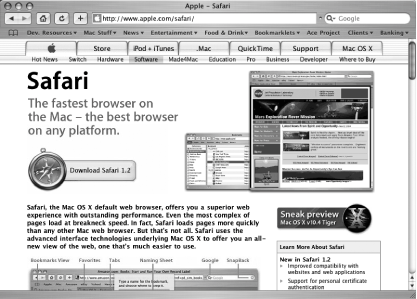Section A.4. Safari
|
A.4. SafariIn August 1997, a momentous deal was struck: Microsoft would invest $150 million in Apple, and in return, Apple would make Internet Explorer the default web browser for its Mac OS operating system for the next five years. Less than six months later, IE 4.0 for the Mac was released. When IE 5.0 was released for the Mac in March of 2000, it was a breakthrough web browser, with excellent support for web standardssupport, actually, that was way ahead of the Windows version of IE at the timeand innovative features that, again, the Windows version lacked (and still does!). Over the next few years, though, real work on the Mac IE browser pretty much stalled, as Microsoft contented itself with bug fixes and maintenance releases, culminating in the 5.2.1 release of July 2002. After that, nothing. Meanwhile, Apple was hard at work on a browser of its own, to be based on the open source web browser Konqueror and named Safari. Steve Jobs announced Safari at the January 2003 Macworld Expo, explaining that the new browser was several times faster than the browser it was replacing, Internet Explorer. June 2003 became a watershed month. On June 13, Microsoft announced that it was ceasing all further development on standalone versions of IE for the Mac, although it would continue to support the software for the foreseeable future and would still provide IE as part of its MSN subscription service for Mac users. The reason? According to Microsoft, it was Safari. Today, Safari, pictured in [click here], is the most widely used browser on Mac OS X.
You have to be running at least Mac OS X 10.2 (Jaguar) to get Safari. If you're running 10.3 (Panther) or later, Safari comes preinstalled with the OS. A.4.1. BackgroundSafari actually uses KHTML, the rendering engine created and used by Konqueror: Apple successfully broke past the "not invented here" syndrome and realized that it could make good use of open source technologies for its new browser, thus saving itself a lot of time and money. Furthermore, Apple has been very good about living up to its responsibilities under Konqueror's open source license and has been releasing its updates and fixes back to the Konqueror developers, so that everyone benefits. Safari left beta in June 2003, when Version 1.0 was released. Version 1.1 came out in October of that year, for OS X 10.3 only. The current release is 1.2, available for OS X 10.3 only and sporting a number of new features and performance enhancements. Apple has announced that the new version of Safari, due along with the next release of Mac OS X (codenamed Tiger) sometime in 2005, will include several new features, including a built-in RSS reader (for more on RSS, see Section 5.7.2), private browsing (which doesn't record any information about the web sites you visit), the ability to easily archive and e-mail web pages, and searchable bookmarks. A.4.2. What's Cool About Safari?If you use Mac OS X, you can use other browsers, but you'll probably use Safari at least some of the time, if for no other reason than that it is the default on your operating system. Fortunately, Safari is a very good browser and is constantly getting better. Safari includes all the usual features of good current browsers, including great support for web standards (including HTML, XML, XHTML, the DOM, and JavaScript), the almost-ubiquitous Google search box (almost ubiquitous except for IE, that is), tabs, a sophisticated bookmarking interface, automatic form completion, and pop-up blocking. In addition, Safari offers several unique features, including the following:
As everyone who uses computers knows, love 'em or hate 'em, Apple is known for stylish, elegant, user-friendly software and hardware, and Safari continues that tradition. A.4.3. What Needs Work?Safari is good, but it's not perfect. It's a young browser, and KHTML still needs a bit of work so that it renders web pages perfectly. It's almost there, but some problems still exist. There are also some minor stability issues still to be ironed outSafari crashes too often at this stage, but its crash reporting tool will help ensure that the number of crashes decreases as the browser matures. And of course, being open source software, it's constantly improving. Frankly, the biggest problem with Safari is that it runs only on Mac OS X! It would be great if Apple ported it to run on Windows, but that will never happen. Ah, wellI can dream. |
|
EAN: N/A
Pages: 93

 Reset Safari), and Safari erases your browser history, cache, download list, Google searches, cookies, saved names and passwords, and more. One click, and your secrets are safe.
Reset Safari), and Safari erases your browser history, cache, download list, Google searches, cookies, saved names and passwords, and more. One click, and your secrets are safe.